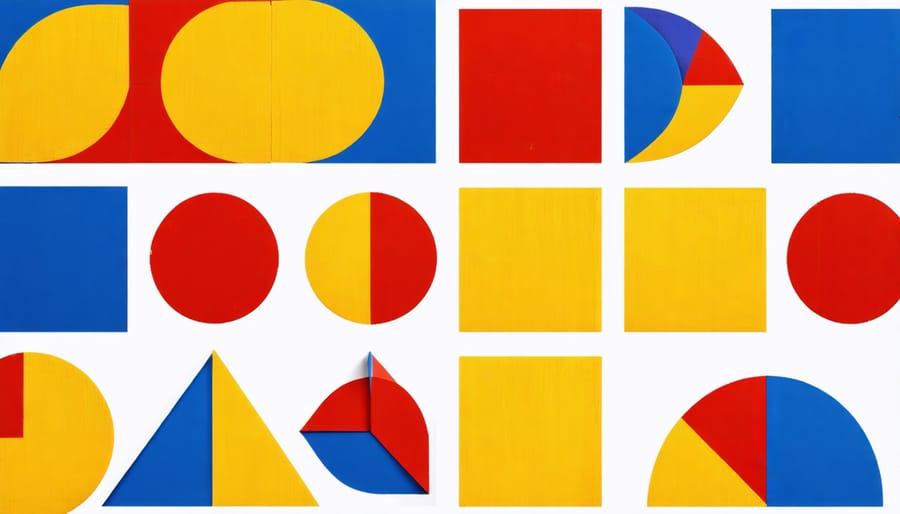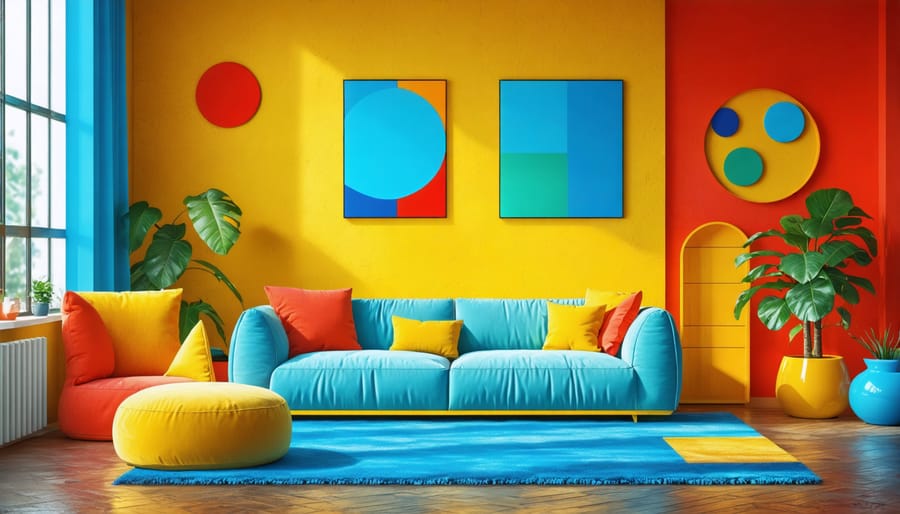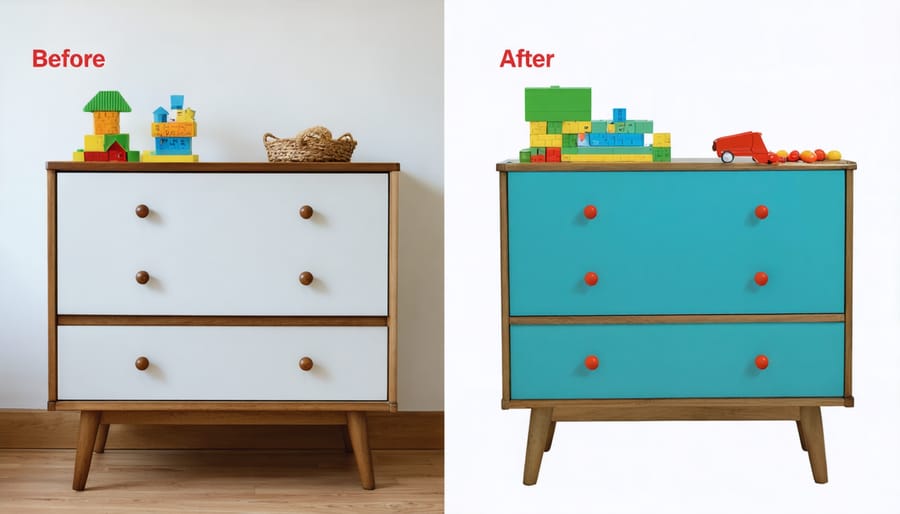Transform your living space into a playful paradise with Kindercore design principles that blend childlike wonder with sophisticated style. This bold aesthetic movement champions primary colors, geometric shapes, and whimsical elements to create spaces that spark joy while maintaining adult sophistication.
Born from the intersection of minimalism and childhood nostalgia, Kindercore has emerged as 2024’s most refreshing interior design trend. Think building blocks reimagined as sculptural furniture, crayon-bright color blocking on walls, and purposefully playful accessories that make every room feel like a creative sanctuary.
Whether you’re redesigning a home office or revamping your living room, Kindercore offers a unique opportunity to embrace joy without sacrificing style. This approach challenges traditional design rules, encouraging adults to reclaim the fearless creativity of childhood while creating spaces that feel both energizing and sophisticated.
For those tired of sterile minimalism or overwhelming maximalism, Kindercore presents a perfectly balanced alternative that proves growing up doesn’t mean giving up on fun.
What Makes Kindercore Design So Special?
Primary Colors and Bold Shapes
At the heart of kindercore lies a bold and playful approach to color theory in design, featuring primary colors that instantly grab attention. Think vibrant yellows, pure reds, and deep blues that wouldn’t look out of place in a modern art museum or a creative preschool. These colors aren’t shy – they’re meant to make a statement and bring joy to your space.
Geometric shapes play an equally important role in this aesthetic. Circles, triangles, and squares appear in their most basic, pure forms, often overlapping or creating interesting patterns. You’ll find these shapes on everything from wall art and throw pillows to area rugs and decorative objects. The beauty of kindercore lies in its simplicity – these fundamental shapes and colors work together to create spaces that feel both sophisticated and playful.
What makes this combination so effective is how it balances visual impact with clean lines. Unlike more complex design styles, kindercore’s use of primary colors and basic shapes creates rooms that feel energetic yet ordered, making them surprisingly versatile for modern homes.

Playful Yet Sophisticated
While kindercore embraces childlike elements, it’s far from childish. This aesthetic masterfully combines playful shapes and bold colors with sophisticated design principles to create spaces that feel both joyful and refined. Think of it as finding the sweet spot between a modern art gallery and a creative playground.
The key lies in balance and intentional design choices. Rather than flooding a room with rainbow colors, kindercore often pairs two or three bold hues with neutral backgrounds. Clean lines and geometric shapes add maturity to whimsical elements, while high-quality materials elevate playful pieces from simple toys to artistic statements.
For example, a living room might feature a curved, primary-colored sofa against crisp white walls, or a home office could pair professional furniture with oversized building block-inspired storage units. The goal is to create spaces that spark joy and creativity while maintaining an air of adult sophistication.
This balance makes kindercore particularly versatile, allowing it to adapt to various settings from modern urban apartments to family homes, without ever feeling out of place or overwhelming.
Creating Your Kindercore Space
Living Room Elements
Transform your living room into a playful paradise with kindercore’s signature elements. Start with a bold, primary-colored sofa – think sunshine yellow or electric blue – as your statement piece. Complement it with rounded, cloud-like armchairs that feature soft, plush materials in contrasting colors.
Add geometric accent pieces like circular side tables or zigzag-patterned storage ottomans. The key is to incorporate simple shapes that feel almost child-like in their design, but executed in sophisticated materials. Consider a curved arc floor lamp in metallic gold or a collection of oversized building block-style floating shelves.
For your walls, opt for cheerful wallpaper featuring repeated patterns in primary colors, or create an accent wall with bold color blocking. Incorporate playful artwork featuring simple shapes, faces, or abstract designs that maintain the aesthetic’s whimsical nature.
Accessorize with oversized throw pillows in various geometric shapes and mix in plush textiles like shag rugs in candy-bright colors. Don’t forget practical elements – storage solutions can include modular cube units in rainbow hues or toy chest-inspired coffee tables that double as storage spaces.
Balance is crucial – while the style embraces childlike elements, maintain sophistication through high-quality materials and thoughtful arrangement. Mix in metallic accents and clear acrylic pieces to add a contemporary edge to the playful aesthetic.

Kitchen and Dining Areas
The kitchen and dining areas offer exciting opportunities to embrace the playful spirit of kindercore. Start with bold primary colors in unexpected places – think sunshine yellow cabinet doors, cobalt blue dining chairs, or fire engine red pendant lights. For a less permanent commitment, introduce colorful dinnerware, serving bowls, and table linens in geometric patterns and solid primary hues.
Consider incorporating rounded edges and circular elements, which are quintessential kindercore features. A round dining table, curved bar stools, or circular placemats can add softness to these typically functional spaces. Don’t shy away from mixing patterns – polka dots, stripes, and color blocks can coexist harmoniously when united by a consistent color palette.
Storage solutions can double as design elements with colorful open shelving displaying vibrant cookware and cheerful kitchen accessories. Add whimsy with oversized fruit-shaped bowls or geometric cookie jars that serve both practical and decorative purposes.
For the dining area, create an inviting atmosphere with a mix of seating options in different primary colors. A statement wall in a bold geometric pattern or color block design can serve as an eye-catching backdrop. Remember to balance the playful elements with some neutral spaces to prevent visual overwhelm – white walls or natural wood elements can provide necessary breathing room while letting your kindercore pieces shine.
Bedroom and Office Spaces
Bringing kindercore into bedrooms and office spaces requires a delicate balance between playfulness and functionality. In bedrooms, start with a neutral base and layer in bold, primary colors through bedding, artwork, or an accent wall. Consider incorporating geometric shapes through decorative pillows or wall decals, but keep the overall arrangement simple to maintain a restful atmosphere. A curved headboard in a vibrant yellow or blue can become a striking focal point while staying true to the aesthetic.
When designing functional workspaces, kindercore elements can actually boost creativity and mood. Choose a desk with clean lines and rounded corners, perhaps in white or a solid primary color. Add personality with colorful file organizers, desk accessories, and playful storage solutions. Consider incorporating modular shelving units in bold colors or geometric patterns that can be rearranged as needs change.
For both spaces, lighting plays a crucial role. Select fixtures with simple, rounded shapes in bright colors or metallic finishes. Wall sconces with circular backplates or desk lamps with ball-shaped bases work particularly well. Remember to maintain breathing room between decorative elements – while kindercore embraces bold choices, cluttered spaces can diminish both rest and productivity. The key is finding the sweet spot between energetic design and practical functionality.
DIY Kindercore Projects
Weekend Paint Projects
Transform your space with these cheerful weekend painting projects that perfectly capture the kindercore aesthetic. Start with a simple geometric accent wall using bright, primary colors. Create a repeating pattern of circles, triangles, or squares using painter’s tape, then fill in with bold yellows, reds, and blues. For extra whimsy, try painting an oversized rainbow arch behind your bed or sofa.
Looking for something smaller? Give old furniture pieces new life with color blocking. Paint dresser drawers in alternating hues, or add playful polka dots to a basic side table. Even your plant pots can get the kindercore treatment – try painting thick stripes or abstract shapes in contrasting colors.
Don’t forget about doors! Transform interior doors into statement pieces by painting them in cheerful colors like bubblegum pink or sunshine yellow. Add extra personality with simple geometric patterns along the panels.
For a subtle touch, create a DIY wall border using painter’s tape and two or three complementary colors. This works especially well in home offices or reading nooks where you want just a hint of playfulness.
Remember to use non-toxic, low-VOC paints, especially if you’re painting children’s spaces. Always test your colors on a small area first, and don’t be afraid to embrace imperfection – kindercore is all about joy and self-expression, not perfection!
Upcycled Furniture Ideas
Transform your existing furniture into playful Kindercore masterpieces with these creative upcycling ideas. Start with a basic wooden chair by painting it in bold, primary colors – try color blocking the seat in yellow and the legs in blue for maximum impact. Old dressers can become statement pieces by adding geometric shapes in contrasting colors, like red circles and black triangles on a white base.
Give dated side tables new life by wrapping the tops in colorful vinyl or contact paper featuring simple, childlike patterns. For wooden cabinets, consider painting each door a different primary color and adding oversized, round wooden knobs in contrasting hues. Even a plain bookshelf can embrace the Kindercore aesthetic with alternating shelves painted in different colors.
Don’t forget about soft furnishings – recover old ottoman cubes in bright, solid-colored fabric and add geometric appliques. Transform boring lamp bases with stripes of primary colors, and spray paint old picture frames in bold yellows, reds, or blues for an instant Kindercore gallery wall.
For a subtle touch, update drawer pulls and cabinet handles with oversized, geometric shapes in primary colors. Remember, the key to successful Kindercore upcycling is embracing simplicity in shape while being bold with color choices. Even the most basic piece of furniture can become a playful focal point with the right paint job and creative vision.

Common Mistakes to Avoid
While kindercore’s playful nature can be enticing, there are several common pitfalls to avoid when incorporating this aesthetic into your space. The key is striking the right balance between whimsy and sophistication.
First, avoid going overboard with primary colors. While bold hues are central to kindercore, using too many bright colors simultaneously can create visual chaos. Instead, choose two or three main colors and complement them with neutral tones to create breathing space.
Don’t fall into the trap of making your space look like a literal kindergarten classroom. The goal is to capture childlike wonder while maintaining an adult living space. Mix playful elements with sophisticated pieces, such as pairing a geometric print sofa with mature artwork or combining rounded furniture with sleek lighting fixtures.
Another common mistake is using low-quality materials in an attempt to keep things playful. Invest in well-made pieces that will last, even if they feature fun designs. Quality materials ensure your space maintains its charm without looking cheap or tacky.
Avoid cluttering your space with too many statement pieces. While kindercore embraces bold designs, too many competing elements can overwhelm a room. Choose one or two focal points and let them shine by keeping surrounding elements more subdued.
Be careful not to ignore functionality in pursuit of aesthetics. Your space should still serve its purpose effectively. Ensure furniture arrangements make sense for daily life, and storage solutions remain practical despite their playful appearance.
Lastly, don’t forget about texture variation. Many people focus solely on color and shape but neglect the importance of different textures. Mix smooth surfaces with plush fabrics and tactile elements to create depth and interest in your kindercore space.
Embracing Kindercore in your home is more than just following a trend – it’s about rediscovering joy and playfulness in your living spaces. This vibrant aesthetic offers endless possibilities for personalization, allowing you to create environments that spark creativity and bring smiles to everyone who enters.
Remember that Kindercore doesn’t mean transforming your home into a kindergarten classroom. Instead, it’s about thoughtfully incorporating playful elements, bold colors, and whimsical shapes in ways that feel sophisticated and intentional. Start small with accent pieces or a feature wall, and gradually expand as you become more comfortable with the style.
Don’t be afraid to experiment with different color combinations and geometric shapes. The beauty of Kindercore lies in its flexibility – you can dial up the vibrancy for maximum impact or tone it down for a more subtle approach. Mix and match patterns, play with scale, and trust your instincts when it comes to what feels right in your space.
Most importantly, have fun with the process! Kindercore is about embracing childlike wonder while maintaining adult sensibilities. Whether you’re renovating an entire room or simply adding a few playful touches, let this aesthetic bring out your creative side and inject some much-needed joy into your living environment.
Consider documenting your Kindercore journey – you might be surprised at how this cheerful design approach transforms not just your space, but your daily mood as well. After all, who couldn’t use a little more color and playfulness in their life?
